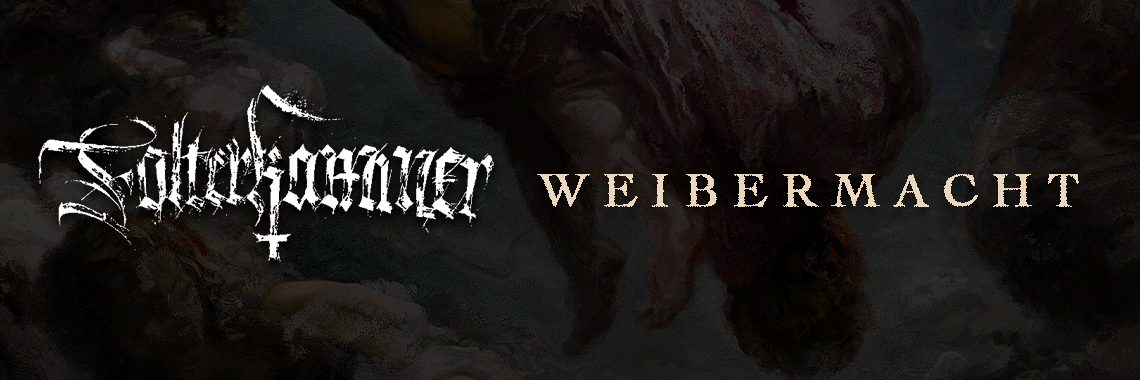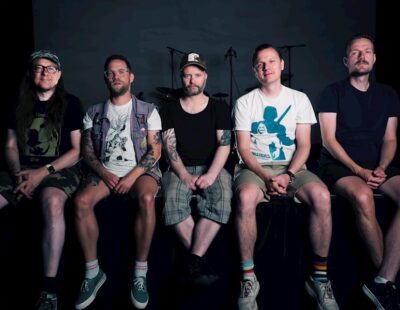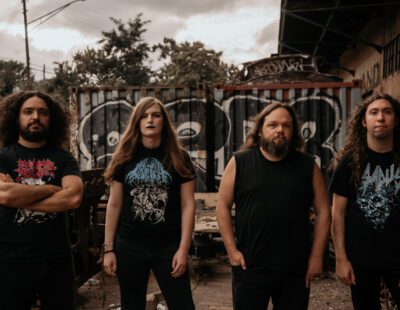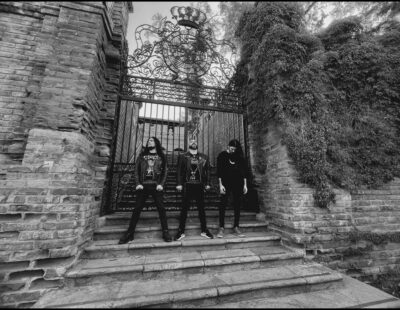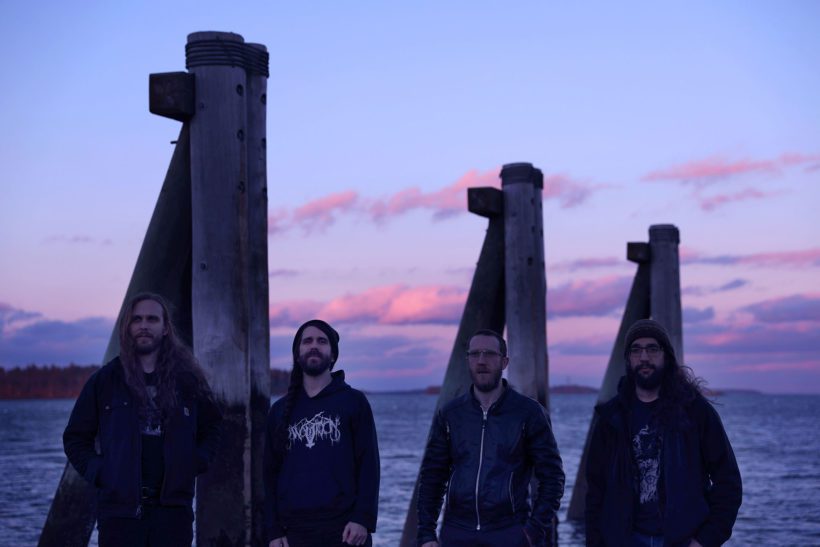
There are albums of the year. And there are Albums Of The Year. Two very different sentiments when considering what might be top contender in 2019. Well, Maine black/folk/post metal outfit Falls of Rauros may just have an Album Of The Year on their hands with their new and expansive Patterns in Mythology effort (Gilead Media). The Portlanders have been vying for top positions ever since Believe in No Coming Shore hit the (smart) metal-minded in 2014. Truly, Patterns in Mythology, with its more metallic and aggressive disposition, sees the quartet expanding its horizons by offering a riff-view into the heart of Maine and across its rugged shoreline.
Just as Ulver (Bergtatt), Agalloch (The Mantle), Wolves in the Throne Room (Two Hunters), Drudkh (Autumn Aurora), and October Falls (The Womb of Primordial Nature) changed the face of sylvan/autumnal metal when they were released, so too does Falls of Rauros’ Patterns in Mythology alter metal in the Year of the Pig. Tracks like the “Détournement,” with its introspective angst, and “Weapons of Refusal,” with its thalassophilic insight–dangerous yet beautiful–draw the listener into Falls of Rauros’ world. Elsewhere, the arboreal drang of “Memory at Night” sets the album off to the end, but the real focal point are the pair of “Last Empty Tradition” and “New Inertia.” On these two tracks, Falls of Rauros transcend Maine, its environs, and its traditions, but are wholly indebted to the petrichor, the smell of pine, the roar of the ocean, and the old lighthouse that are all intrinsically woven into Maine’s environmental fabric.
Join Falls of Rauros’ Aaron Charles and Decibel as we walk through the digital forest together.
One tenet you’ve maintained over the years is not repeating the music of the previous album (or albums). How has that manifested itself on new album, Patterns in Mythology?
Aaron Charles: It’s always seemed apparent that we’d be doing a disservice to ourselves and our fans to tread the same waters from record to record; this is something we keep in mind whenever we begin work on a new set of songs. The Light that Dwells in Rotten Wood was grander and more emotional than our more stoic debut, Hail Wind and Hewn Oak. 2014’s Believe in No Coming Shore featured a “scaled down” sound compared to its predecessor; less massive in scope and much more folk influenced (particularly American folk and alt-country) and somber. Our last record, Vigilance Perennial, gutted out the more identifiable “folk” parts and replaced them with an amalgamation of “rock” influences. When the Patterns in Mythology sessions got underway we wound up looking to metal for inspiration in a way we hadn’t for years. We rarely truly abandon ideas we’ve cultivated on past releases; you can hear sections that call to mind all of our previous records on Patterns in Mythology, but there is something more overtly “metal” about this record than the last few. Around the time we wrote this record I was revisiting and reassessing a lot of personal classics, stuff I listened to ceaselessly back in high school, to find out whether or not they held up, and some of that inevitably seeped into Patterns. We also wanted to make this record our most detailed, from the production to the arrangements, and I think that attention to detail is something we had yet to realize until now.
What were some of the parameters you put into the songwriting sessions for Patterns in Mythology? Maybe the parameter of “no parameter” defined how things progressed?
Aaron Charles: This record was interesting for us because it is the first one we wrote at a distance from one another. I was living out of state for a spell, so a good number of the seminal riffs on this record came from me just playing in isolation, or Jordan [Guerette] working in Maine all by himself. There was less communication and collaboration than usual, at least at the outset. I made a trip up to Maine last summer to work on the record in person with the band and we rehearsed frequently during that short stint to get as much face-to-face time in as was reasonable. After that, the rest of the record was completed in isolation once again; we had to rely on each other to do our homework. Luckily, we trust one another’s taste and discretion, and the songs built themselves into complete pieces without any major obstacles. In that way, distance was the foremost parameter for this record. Distance gave the amount of meticulous detailing we could achieve a ceiling, which I think worked in this record’s favor; it kept us from overdoing the compositions and working the songs to death. Melodies and layers came to fruition without much feedback from bandmates, a good deal of “arrangement sorting” was done on the spot in the studio, or verbally before going in to record the following day. Ultimately, I think we worked well under the pressure of these novel circumstances.
Counterpoint, as a musical idea, is pervasive in Falls of Rauros. What is it about two parallel lines complementing and competing that appeals to you as songwriters?
Aaron Charles: We try to fill our songs with plenty of small details, whether they take the form of melodies, rhythms, effects or tonal shifts, etc. A neat way to bring detail to a composition is to layer our two guitars and bass in such a way as to produce some contrapuntal ear candy. Oftentimes more traditional metal bands will stick to rhythm guitars (generally two guitars playing in unison) which is a fantastic way to sound heavy, embellished with occasional solo lead guitar parts or a tightly harmonized melody. This approach obviously works brilliantly; it’s been a staple of the metal vocabulary since its inception. Using counterpoint, however, can yield mesmerizing, unusual, and surprising results. Sometimes these parts come down to trial-and-error, in which we would prefer to draw from a riff or melody elsewhere in a song or on the album than create an entirely new, unrelated part. Cross-pollinating our songs in such a way almost always results in some sort of counterpoint as the lead guitar and rhythm guitar derive from disparate sources, often ebbing and flowing in different ways, intersecting and diverging unpredictably along the way. Counterpoint is also a useful method for adding some tension and dissonance to a song by utilizing guitar lines that are actually very melodic when heard independently from one another; this helps us avoid writing any ham-fistedly dissonant parts for the sake of sounding “intense” or “evil”. If the instruments participating in this push / pull dynamic are treated with different effects and mixed in such a way as to emphasize contrast, that’s the icing on the cake.
Can the state of Maine be a factor in your sound? I gather the inclusion of Winslow Homer’s artwork answers this question in full, but I’m curious how your environment penetrates your being and ultimately your approach to musical art.
Aaron Charles: The state of Maine absolutely plays a role in our music, several roles in fact. Maine is not a very populous state; Portland is the largest city and yet the metal scene here is very small and insular. When we got our start, we were entirely detached from any local scene or outside collaboration. Such isolation allowed us to pursue a rather idiosyncratic path with our early demos, playing a bizarre mixture of ultra lo-fi black metal convoluted with a plethora of unsound decisions and unchecked impulses. Back then there was nobody around to write this kind of music with; we were left to ourselves to figure it out and hone our approach. Even to this day, with a couple handfuls of good friends in the Maine metal scene, we exist in relative isolation when compared to an actual major metropolitan area. Outside of the city there is an abundance of inspiration to be found in the wilderness of Maine, from the rugged and humble mountains of western Maine to the endless and breathtaking rocky coastline hugging the Atlantic. Maine is a quiet place, and much of Maine is an impoverished place, and that quiet and that poverty can well and truly be felt. As people who’ve spent essentially our whole lives as residents of Maine there is no escaping that heaviness.
And how did you come across Homer’s art? Did you immediately know that specific pieces fit Falls or did that come after some introspection?
Aaron Charles: The four of us grew up and went to school in a suburb of Portland called Scarborough, which is where Winslow Homer took up residence and painted many of his most famous pieces. He had a studio on Prout’s Neck near Scarborough Beach which was just a few-minutes-drive from all of our childhood homes. Homer is someone you learn about from a very young age, as famous and noteworthy artists from Maine are few and far between, so to have such a notable artist live in our hometown meant that we’d hear about him ceaselessly in those K-12 school years. A few years back we used a drawing Homer made for a newspaper as one of our shirt designs–it was a depiction of a hunt entitled “Deer-Stalking in the Adirondacks in Winter.” We liked the aesthetic of Homer’s work, and it seemed highly compatible with the aesthetics we nurture in this band, so the idea came about to use one of his works for an album cover. Being from a coastal town, the ocean is a major part of our identity; Homer has a large body of coastal and ocean-themed paintings to draw from. We landed on a piece called “Sunlight on the Coast” which was particularly appealing in that it is devoid of any trace of humankind and rather focuses on the beauty and horror of the Atlantic Ocean, threatening the shoreline and snarling at the unwelcome. I’ve always found the ocean to be a terrifying place, much more so than a deep forest or a snowy mountain range. Despite the hostility the aforementioned are capable of conjuring, nothing on this planet is more hostile than the ocean.
I like that there are environmental sounds in the music. Is that idea more to put Maine, for example, into your music or is it more about achieving a specific atmosphere?
Aaron Charles: The field recordings are simply there to add to, and enhance, the prevailing atmosphere or narrative; they are not location specific in any way. I’ve always enjoyed field recordings on black metal records, but it sometimes irks me when they act as filler, either extending for too long at the beginning or end of a track and properly testing my patience. We didn’t use any field recordings for their own sake but only to complement a pre-existing musical idea; atmosphere is important, but we wanted to keep the record lean and free of unnecessary fluff. In “Weapons of Refusal,” the field recording roughly halfway through is low in the mix and subtle, but when one listens intently we think the song achieves a higher degree of listener immersion. This understated portion of the song is intended to be a moment of reflection, and it’s a turning point in the arc of the song both musically and lyrically. The instruments from this point forward in the track open up, letting in more air and space, and the lyrics shift toward something more optimistic and tinged with hope than the first half of the song which is a rather dismal affair. Anyway, for the most part there are hardly any field recordings to be found on the record.
I thought the song “Renouvellement” was a brave move. Do you find that stripping away the distortion and screams offers something different to you as a songwriter and player? The openness of it can be a bit daunting.
Aaron Charles: We’ve always enjoyed placing an “interlude” or two on each record because, while they exist to serve each album as a whole, they operate independently from the songs surrounding them. Typically, we write these tracks with the understanding that we won’t play them live, which liberates us to freely experiment with instruments we won’t have access to while on tour and add a handful of layers that we won’t be able to perform in a live setting. “Renouvellement” was largely Jordan’s project; he certainly did the lion’s share of the work on that track, including penning some brief lyrics in French and singing them. I suppose I played a hand in the composition in that it includes chord progressions and melodies that reference other parts of the album, but I took a distant back seat on this one. Jordan leads a chamber group called Forêt Endormie in which he composes all of the music, so “Renouvellement” was not uncharted territory for him. You’re right though: the short experimental or instrumental tracks found on our records absolutely offer a different sort of fulfillment as songwriters and composers than when writing metal songs, although most of our metal songs feature many of the elements found in our experimental tracks anyway, such as clean or acoustic guitars, synths, and auxiliary percussion. Strange as it might sound, I think we all feel pretty confident about the non-metal aspects of our music, and we’re quite comfortable when writing an introspective folk, rock, or classical inspired part, oftentimes even more confident than when we’re writing a metal part; most black metal bands are more evil sounding than us, death metal bands rip way harder, bona fide prog-metal bands shred circles around us, but I think we hold our own when it comes to incorporating outside influences in a cohesive and maybe unusual manner.
How would you describe the overall sound of Patterns in Mythology?
Aaron Charles: The driving force behind the record is certainly melody; it is an overtly melodic record with more prominently metal features that our last 3 records. As stated earlier, a push / pull dynamic is prominent. Every track capitalizes on the luxury of having multiple songwriters in the band and there is a strict focus on interaction between every instrument. Ray is a musical drummer and he very intentionally works in tandem with the rest of us to glue the compositions together while adding tasteful nuances along the way. In some ways Patterns in Mythology is our heaviest record; in part due to the production job by Colin Marston, and in part due to the greater prevalence of metallic phrasing and energy. Nonetheless, it is certainly a Falls of Rauros record, and it sounds like one; while we try to evolve from release to release, we exercise restraint regarding how far to take any new developments. We don’t have any interest in changing genres entirely or indulging ourselves to the point of unrecognizability. To a listener familiar with our past works, Patterns in Mythology should sound like a logical follow-up to 2017’s Vigilance Perennial.
The lyrics of the past have been metaphorical yet personal. If something bears repeating it’s likely the lyrical approach. What can be said about Patterns in Mythology’s lyrics and how should fans read them?
Aaron Charles: The lyrical approach on Patterns in Mythology is similar to the approach I took on the last two records. It is nowhere near as straight-forward and overtly “political” (by our standards) as The Light that Dwells in Rotten Wood, offering instead a more metaphorical and personal take on familiar themes. I try not to give too detailed an explanation of any of my lyrics, particularly the “personal” lyrics which would fall flat for anybody but myself if explained point blank. What I can say is this: depending on how a person reads them, the songs generally alternate between offering a ragged optimism and an embittered pessimism. The more “optimistic” of the tracks, “Weapons of Refusal” and “Last Empty Tradition,” were inspired to a degree by Belgian writer and Situationist thinker Raoul Vaneigem, but some of his ideas were on my mind when I wrote lyrics to “New Inertia” and “Memory at Night” as well. Jordan took care of the lyrics on “Renouvellement” as he is the only French-speaker in the band, but from my outside perspective I’d say that those lyrics similarly tread a grey area between optimism and pessimism depending on how you read them. At the end of the day I would rather leave our lyrics up for interpretation; ambiguity and uncertainty are very real parts of life.
You’ve continued to work with Colin Marston (at Menegroth, no less). What is it–beyond the Tolkien connection anyway–that Marston offers Falls of Rauros? Not just at the producer or engineer level either. At all levels, really.
Aaron Charles: We first worked with Colin on Vigilance Perennial, although he only mastered that record. He did such great work on the master for Vigilance Perennial that we decided the next record would be even better if we took a couple trips down to his studio to track it in its entirety at Menegroth, building it from the ground up with the help of his expertise and watchful eye. The decision proved to be well worth it; we got along wonderfully with Colin, who is immensely easy-going yet entirely professional. The bottom line is that if we’re going to spend hours and hours working with someone, for days on end, we’re going to need to get along! He’s also the kind of engineer that possesses such a wide knowledge of strange and unconventional music that he doesn’t insist on doing anything by the books or chasing a sterile modern metal production job. Furthermore, he advocates for dynamics in metal, avoiding the typical overly loud, brickwalled-compression sound heard on many newer metal records fighting to be the heaviest. Music is art, not a competition, and he thoroughly understands and encourages that mindset. Colin is a relatively hands-off producer but isn’t afraid of throwing his two-cents in when needed, which can be invaluable when making on-the-fly decisions in the tracking or mixing phase. I think he understood what we were going for with this record and helped us achieve that without overdoing any aspect of it. That’s a fine line to walk.
What are Falls’ plans post-release? I know there’s always talk of shows, but is there anything concrete planned beyond the Wayfarer tour?
Aaron Charles: There is nothing concrete planned at the moment. We tend to take things one step at a time; first we’ll release this record, then go on a short tour with Wayfarer in mid-to-late July. After that, who knows? We’ll absolutely play some other shows here-and-there, and tour more extensively to support Patterns in Mythology periodically throughout the next year or two. We all work jobs and have other obligations so we’re by no means a touring machine, but rest assured, we will play out in the world as the opportunities arise. And then, when the time is ripe, we’ll slowly begin working on the next record. Time will tell all.
** Falls of Rauros’ new album, Patterns in Mythology, is out now on Gilead Media. Or it direct from the band digitally via Bandcamp (HERE). Or, order it on CD and LP from Gilead Media (HERE). To read more about Falls of Rauros, check out Decibel #178 (HERE).

